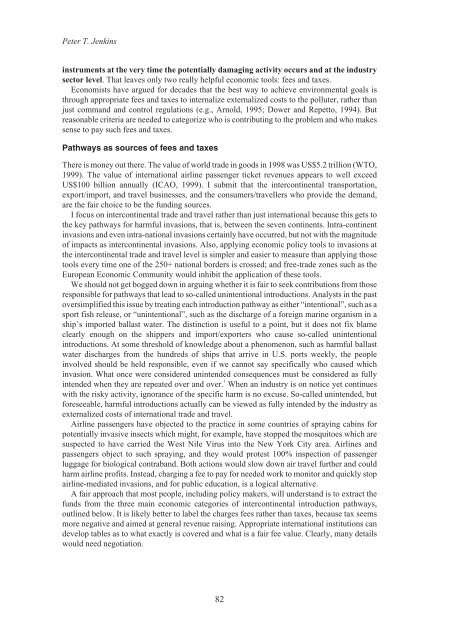Alien Species.vp - IUCN
Alien Species.vp - IUCN
Alien Species.vp - IUCN
You also want an ePaper? Increase the reach of your titles
YUMPU automatically turns print PDFs into web optimized ePapers that Google loves.
Peter T. Jenkins<br />
instruments at the very time the potentially damaging activity occurs and at the industry<br />
sector level. That leaves only two really helpful economic tools: fees and taxes.<br />
Economists have argued for decades that the best way to achieve environmental goals is<br />
through appropriate fees and taxes to internalize externalized costs to the polluter, rather than<br />
just command and control regulations (e.g., Arnold, 1995; Dower and Repetto, 1994). But<br />
reasonable criteria are needed to categorize who is contributing to the problem and who makes<br />
sense to pay such fees and taxes.<br />
Pathways as sources of fees and taxes<br />
There is money out there. The value of world trade in goods in 1998 was US$5.2 trillion (WTO,<br />
1999). The value of international airline passenger ticket revenues appears to well exceed<br />
US$100 billion annually (ICAO, 1999). I submit that the intercontinental transportation,<br />
export/import, and travel businesses, and the consumers/travellers who provide the demand,<br />
are the fair choice to be the funding sources.<br />
I focus on intercontinental trade and travel rather than just international because this gets to<br />
the key pathways for harmful invasions, that is, between the seven continents. Intra-continent<br />
invasions and even intra-national invasions certainly have occurred, but not with the magnitude<br />
of impacts as intercontinental invasions. Also, applying economic policy tools to invasions at<br />
the intercontinental trade and travel level is simpler and easier to measure than applying those<br />
tools every time one of the 250+ national borders is crossed; and free-trade zones such as the<br />
European Economic Community would inhibit the application of these tools.<br />
We should not get bogged down in arguing whether it is fair to seek contributions from those<br />
responsible for pathways that lead to so-called unintentional introductions. Analysts in the past<br />
oversimplified this issue by treating each introduction pathway as either “intentional”, such as a<br />
sport fish release, or “unintentional”, such as the discharge of a foreign marine organism in a<br />
ship’s imported ballast water. The distinction is useful to a point, but it does not fix blame<br />
clearly enough on the shippers and import/exporters who cause so-called unintentional<br />
introductions. At some threshold of knowledge about a phenomenon, such as harmful ballast<br />
water discharges from the hundreds of ships that arrive in U.S. ports weekly, the people<br />
involved should be held responsible, even if we cannot say specifically who caused which<br />
invasion. What once were considered unintended consequences must be considered as fully<br />
intended when they are repeated over and over. 1<br />
When an industry is on notice yet continues<br />
with the risky activity, ignorance of the specific harm is no excuse. So-called unintended, but<br />
foreseeable, harmful introductions actually can be viewed as fully intended by the industry as<br />
externalized costs of international trade and travel.<br />
Airline passengers have objected to the practice in some countries of spraying cabins for<br />
potentially invasive insects which might, for example, have stopped the mosquitoes which are<br />
suspected to have carried the West Nile Virus into the New York City area. Airlines and<br />
passengers object to such spraying, and they would protest 100% inspection of passenger<br />
luggage for biological contraband. Both actions would slow down air travel further and could<br />
harm airline profits. Instead, charging a fee to pay for needed work to monitor and quickly stop<br />
airline-mediated invasions, and for public education, is a logical alternative.<br />
A fair approach that most people, including policy makers, will understand is to extract the<br />
funds from the three main economic categories of intercontinental introduction pathways,<br />
outlined below. It is likely better to label the charges fees rather than taxes, because tax seems<br />
more negative and aimed at general revenue raising. Appropriate international institutions can<br />
develop tables as to what exactly is covered and what is a fair fee value. Clearly, many details<br />
would need negotiation.<br />
82












